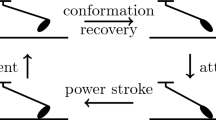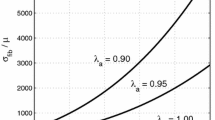Abstract
Hill's three-element model of contracting muscle is expanded by replacing the series and the parallel elastic elements with elastoplastic elements. The contractile element is structurally described making use of the sliding filament theory. The resulting mathematical model is formulated in terms of an evolution variational inequality for a nonlinear and nonlocal transport-type operator. The existence and uniqueness of the solution are described along with a numerical approach.
Similar content being viewed by others
References
Allain G, Colli P (1988) A mathematical study of a muscle contraction model in which the fibre is a continuum of elements. Adv in Appl Math 9:104–126
Brèzis H (1972) Problèmes unilatéraux. J Math Pures Appl 51:1–168
Capelo A, Comincioli V, Minelli R, Poggesi C, Reggiani C, Ricciardi L (1981) Study and parameters identification of a rheological model for excised quiescent cardiac muscle. J Biomech 14:1–11
Colli P (1986) A mathematical model of heterogeneous behavior of single muscle fibres. J Math Biol 24:103–118
Colli P (1989) On a nonlinear and nonlocal evolution equation related to muscle contraction. Nonlinear Anal 13:1149–1162
Colli P, Comincioli V, Naldi G, Reggiani C (1988) Mathematical modelling for contracting muscle. In: Ricciardi LM (ed) Biomathematics and Related Computational Problems, Kluwer Academic, Dordrecht, pp 603–613
Colli P, Comincioli V, Naldi G, Torelli A (1989) Some mathematical and computational aspects of muscle contraction. In: Eisenfeld J, Levine DS (eds) Biomedical Modelling and Simulation, Baltzer Scientific, IMACS 1989, pp 159–161
Comincioli V (1987) Muscle Mathematics. Towards a Mathematical Basis for Muscle Contraction. Pubbl IAN del CNR Pavia, No 589
Comincioli V, Torelli A (1983) Mathematical aspects of the cross-bridge mechanism in muscle contraction. Nonlinear Anal 7:661–683
Comincioli V, Torelli A (1988) A mathematical study of a continuum-state model of muscle contraction. Math Methods Appl Sci 10:289–302
Comincioli V, Torelli A (1988) A mathematical model of contracting muscle with viscoelastic elements. SIAM J Math Anal 19:593–612
Comincioli V, Torelli A, Poggesi C, Reggiani C (1984) A four-state cross bridge model for muscle contraction. Mathematical study and validation. J Math Biol 20:277–304
Cristescu N (1967) Dynamic Plasticity. North-Holland, Amsterdam
Douglas J, Milner FA (1983) Numerical methods for a model of cardiac muscle contraction. Calcolo 20:123–141
Duvaut G, Lions JL (1976) Inequalities in Mechanics and Physics. Springer-Verlag, Berlin
Fung YC (1981) Biomechanics: Mechanical Properties of Biological Materials. Springer-Verlag, New York
Gastaldi L, Tomarelli F (1984) A nonlinear and nonlocal evolution equation describing the muscle contraction. Nonlinear Anal 11:163–182
Glantz AS (1977) A three-element description for muscle with viscoelastic passive elements. J Biomech 10:5–20
Huxley AF (1957) Muscle structures and theories of contraction. Prog Biophys Biophys Chem 7:255–318
Huxley AF (1980) Reflections on Muscle. Liverpool University Press, Liverpool
Kachanov LM (1971) Foundations of the Theory of Plasticity. North-Holland, Amsterdam
Little RC, Wead WB (1971) Diastolic viscoelastic properties of active and quiescent cardiac muscle. Amer J Physiol 221:1120–1125
Miura MR ed (1986) Some Mathematical Questions in Biology-Muscle Physiology. Lectures on Mathematics in the Life Sciences, Vol 16. AMS, Providence, RI
Miyoshi T (1985) Foundations of the Numerical Analysis of Plasticity. Lectures Notes in Numerical and Applied Analysis, Vol 7. North-Holland, Amsterdam
Naldi G (1988) Multiple Actin Sites Models of Muscle Contraction. Mathematical Study. Pubbl IAN del CNR Pavia, No 600
Philips CA, Petrofsky JS (1984) Myocardial material mechanics: characteristics variation of the circumferential and longitudinal systolic moduli in left ventricular dysfunction. J Biomech 17:561–568
Pollack GH (1983) The cross-bridges theory. Physiol Rev 63:1049–1113
Pollack GH, Sugi H (1984) Contractile Mechanism in Muscle. Plenum, New York
Prager W, Hodge PG (1951) Theory of Perfectly Plastic Solids. Wiley, New York
White DCS, Thorson J (1975) The Kinetics of Muscle Contraction. Pergamon Press, Oxford
Author information
Authors and Affiliations
Additional information
Communicated by David Kinderlehrer
This work was supported by M.P.I. (fondi per la ricerca scientifica) and by I.A.N. of C.N.R. Pavia.
Rights and permissions
About this article
Cite this article
Colli, P., Comincioli, V., Naldi, G. et al. A mathematical study of the plasticity effects in muscle contraction. Appl Math Optim 22, 1–26 (1990). https://doi.org/10.1007/BF01447318
Accepted:
Issue Date:
DOI: https://doi.org/10.1007/BF01447318




